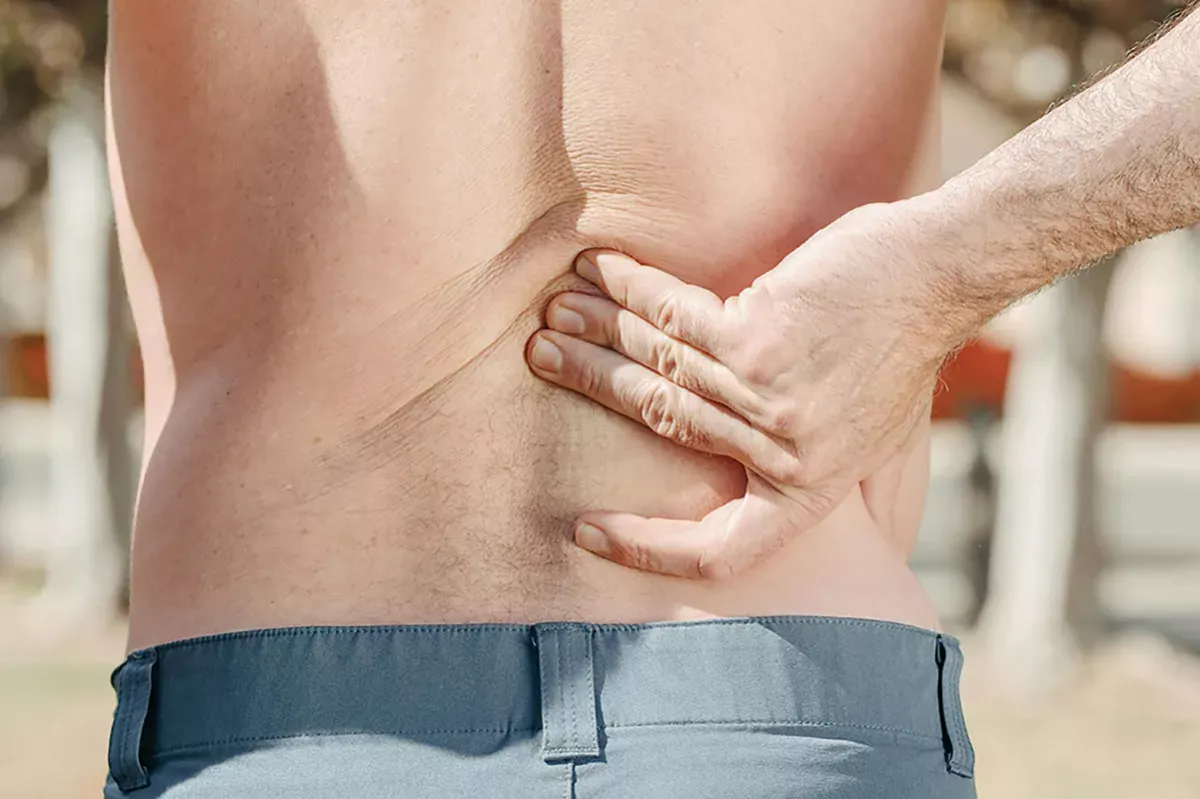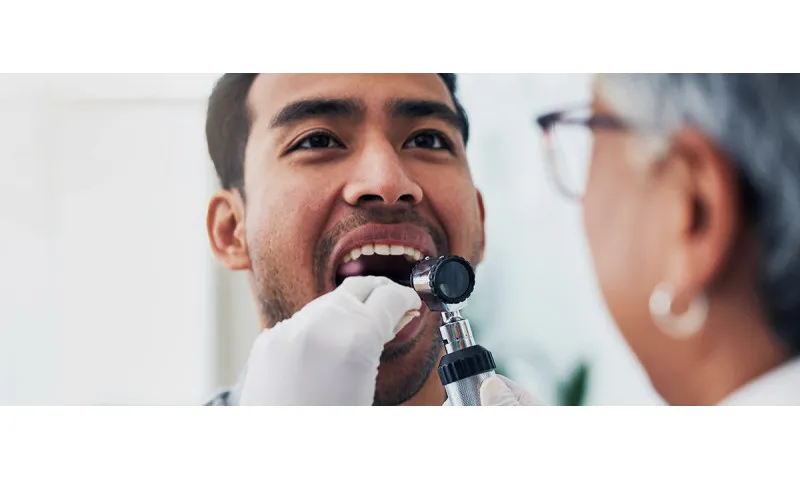Definition: What is CMD?
Craniomandibular dysfunction (English : Craniomandibular Dysfunction; ICD-10 : D76) is often abbreviated as CMD. The term is made up of three parts: cranium is the Latin word for skull, mandibular is the medical term for "belonging to the lower jaw" and dysfunction stands for a disorder. It is therefore an umbrella term for a disorder of chewing function in which the jaw and skull do not interact harmoniously. The clinical picture is often diffuse and can affect various parts of the human body in addition to the teeth, jaw joints and masticatory muscles and worsen general health. Various temporomandibular joint disorders are summarised under CMD.
In healthy chewing function, the teeth, jaw joints and masticatory muscles work together harmoniously. When the mouth is closed, the teeth interlock undisturbed and the masticatory muscles are relaxed. However, if this harmonious unit is disturbed - for example due to a misalignment of the teeth - this has an effect on the entire masticatory system: the masticatory muscles tense up to compensate for the disruptive factor. This tension can lead to pain in the jaw and head area, but also in other parts of the body such as the back. If the malfunction is not treated, the muscles become permanently tense and cause chronic discomfort, which can severely restrict quality of life.
Frequency
CMD is very widespread - however, many people often do not even realise that they are affected. According to the Society for Dental Health, Function and Aesthetics (GZFA), an estimated 20 per cent of the adult German population have CMD complaints that require treatment. Other sources give even higher figures.
Symptoms
The symptoms of CMD can be very varied and affect different parts of the body. A general distinction is made between ascending and descending symptoms. In the case of ascending symptoms, the actual cause of the CMD lies in the lower part of the body (e.g. pelvis or back) and triggers complaints such as jaw pain or neck pain in the upper part of the body. In the case of descending symptoms, it is the other way round: the original cause is, for example, a misalignment of the teeth, which leads to tension in the jaw and has a negative effect on the lower body, which can result in back pain, for example. The spiral of tension can therefore go from top to bottom as well as from bottom to top.
Teeth and jaws
The following symptoms in the dental and jaw area are typical of CMD:
- Toothache
- Jaw pain/tension in the jaw when chewing or at rest
- Jaw joints and/or masticatory muscles sensitive to touch
- Difficulty opening the mouth
- Jaw lock
- Malocclusion (teeth do not fit together when biting)
- Cracking or rubbing in the temporomandibular joint
- Gum recession
- Loose teeth
- Teeth grinding
Good to know:
Teeth grinding is not just a symptom, it can also be the cause of CMD. Constant grinding at night damages the teeth and strains the jaw muscles. You can find out what causes teeth grinding and what you can do about it in our article:
Neck and head area
In the upper part of the body, the following symptoms can be triggered by CMD:
- Earache
- Tinnitus (subjective noises in the ear)
- Sudden deafness
- Sore throat
- Swallowing difficulties
- Headache/migraine
- Pain and tension in the neck
- Pressure behind the eyes
- Sensitive scalp
- Facial pain
- Dizziness
- Light sensitivity
- Burning tongue
Upper body and torso area
The spiral of tension can also extend into the upper body and trunk area and trigger the following symptoms there:
- Tension and pain in the back and shoulders
- Pain in the lumbar spine
- Complaints in the area of the cervical spine (cervical spine syndrome)
- Intervertebral disc problems
- Pelvic obliquity
- Knee pain
- Numbness in arms and fingers
Psychological complaints
In addition to the physical symptoms, psychological complaints can also occur, which often exacerbate the physical symptoms:
- Anxiety disorders
- Depression
- Sleep disorders
Causes: How does CMD develop?
The actual cause of craniomandibular dysfunction is the disruption of the harmonious interaction of teeth, jaw bones, jaw muscles and jaw joints. This disorder can be triggered by various factors:
- Teeth grinding
- Misalignment of the teeth (congenital or due to tooth migration)
- Stress and psychological problems
- Poor posture of the head
- Hormonal disorders
- Poor posture (especially when sitting for long periods)
- Joint inflammation (for example arthrosis)
- Trauma (tooth and jaw injuries; for example, during sport or in an accident)
- Ill-fitting dentures or faulty fillings (too high or too low)
- Tooth loss
- Breakthrough of wisdom teeth
All of these factors can disrupt the harmony in the masticatory system and lead to tension in the jaw muscles and a shift in the position of the temporomandibular joint, which can spiral into the rest of the body.
It is often the case that one factor alone does not trigger any symptoms, but can still be easily compensated for. However, if, for example, an ill-fitting denture is compounded by severe stress, symptoms can suddenly appear - for example in the form of jaw or facial pain.
Good to know:
Do you suspect that your wisdom teeth are about to erupt and are not sure whether you should have them extracted or not? Then take a look at our article on wisdom teeth:
Diagnosis: How is CMD diagnosed?
If you suspect that you are suffering from craniomandibular dysfunction, you are probably wondering which doctor you should go to. The first port of call is usually a dental practice - ideally with dentists specially trained in CMD.
The diagnosis of craniomandibular dysfunction takes place in two or three stages:
- Clinical functional analysis
- Instrumental functional analysis
- Supplementary diagnostics
Clinical functional analysis
During a clinical functional analysis (also known as a manual functional analysis), the dentist examines your jaw very closely. On the one hand, he checks whether your teeth are misaligned and do not interlock properly. On the other hand, they will palpate the chewing muscles and the temporomandibular joint to see if certain areas are sensitive to pressure. He will then check whether you have any restrictions when chewing or moving your jaw and whether there are any noises such as cracking or grinding. Part of the clinical functional analysis is also measuring the mouth opening.
Instrumental functional analysis
As the name suggests, instrumental functional analysis involves the use of aids. Specifically, high-resolution 3D images and impressions of the current state of the dentition are created in this step. The jaw movement is digitally recorded in all directions. The ideal bite can be determined digitally on the basis of this computerised analysis.
Supplementary diagnostics
If the CMD diagnosis is not clear after the first two steps, imaging procedures can be used to provide clarity.
The following methods can be used:
- Magnetic resonance imaging (MRI)
- Computed tomography (CT)
- Dental volume tomography (DVT)
- X-ray examination
Good to know:
How exactly does an X-ray actually work in a dental practice? And is it dangerous? Find out in our article:
Treatment: What is the therapy for CMD?
A detailed diagnostic analysis provides the basis for the treatment of craniomandibular dysfunction. Although the first point of contact is usually a dentist, interdisciplinary diagnosis and treatment strategies should be used for CMD because other parts of the body are often affected in addition to the teeth.
The aim of the treatment is to release the muscle tension as the cause and thus alleviate pain and other symptoms.
Therapists from the following specialisms can be part of an interdisciplinary collaboration:
- Orthodontics
- ENT
- Orthopaedics
- Psychology
- Physiotherapy
- Radiology
- Neurology
- Speech therapy
The treatment of craniomandibular dysfunction is covered by statutory health insurance - this usually applies to the initial examination and diagnosis as well as to the fabrication of a customised occlusal splint and any interdisciplinary treatment procedures.
Bite splint
The first step in treating CMD is a bite splint, which is made using the values from the instrumental functional analysis and brings the temporomandibular joints into the ideal position. This allows the jaw muscles to relax. At the same time, it compensates for misalignments and protects the teeth from enamel damage caused by grinding.
The bite splint is specially made for you by a dental technician and, depending on the severity of the CMD, must be worn either only at night, only during the day or at night as well as during the day. As a rule, those affected feel a significant alleviation of symptoms with the bite splint - sometimes even complete freedom from symptoms!
Dental treatments for CMD
Dental treatment may be necessary to eliminate the cause of the dysfunction - provided the cause lies in the mouth. This includes filling gaps between teeth with implants, grinding down teeth, replacing faulty crowns or fillings and restoring damaged teeth.
If the temporomandibular joints are already chronically inflamed, a dentist can perform temporomandibular joint irrigation. The dentist places two wafer-thin needles into the joint under local anaesthetic to flush it out. This can loosen inflamed cells and remove them from the joint. However, surgery may also be necessary and a temporomandibular joint may need to be replaced.
Good to know:
What types of dentures are there? And how do you find out which one suits you best? Find out in our article:
Physiotherapy for CMD
We already know that a spiral of tension can run through the whole body. Physiotherapy can help to relieve this tension and break the spiral. To do this, your physiotherapist will teach you certain exercises, which you should ideally repeat regularly at home.
Psychotherapy
Stress is a strain on the body and can, among other things, lead to teeth grinding - which in turn can trigger CMD. Mental illnesses such as depression and anxiety disorders can also exacerbate CMD symptoms. On the other hand, the following also applies: if the psychological stress decreases, the symptoms are also alleviated. In psychotherapy, you learn strategies for coping with stress.
Medication
Your doctor may also prescribe medication as part of CMD treatment. These include:
- Painkillers
- Medication for muscle relaxation
- Tranquillisers
- Antidepressants
Alternative treatment methods
Some people have had positive experiences with alternative methods such as acupuncture or osteopathy in the treatment of CMD. However, alternative methods can only be used to supplement conventional medical therapy and cannot replace it.
Homeopathy also offers remedies for CMD. The globules Cina D6, Cuprum metallicum D 12, Magnesium phos. D 12, Phytolacca D 6, Podophyllum D 6 and Zincum metallicum D 12 are said to help against teeth grinding. But be careful: so far there is no scientific proof that homeopathic remedies are effective. An improvement can often be attributed to the placebo effect.
4 tips: What you can do yourself against CMD
In addition to interdisciplinary CMD therapy with occlusal splints, you can also actively alleviate your symptoms yourself. We have put together a few helpful tips for you here:
1. Relieve pain with heat
Heat therapy helps with pain in joints and muscles - for example with a red light lamp or warm, damp flannels. A warm bath can work wonders for large areas of tension.
2. Recognising triggers
Try to recognise patterns in your symptoms and observe yourself. When does pain occur? When are you particularly stressed? You can actively counteract these situations with relaxation exercises.
3. Reduce stress
Stress is an important factor in CMD. For most people, the symptoms get worse under stress and better with less stress. Effective methods for reducing stress include sport, relaxation exercises, yoga, progressive muscle relaxation and exercise in the fresh air.
4. Do jaw exercises
The problem with craniomandibular dysfunction is often tense jaw muscles. You can do simple exercises at home to stretch and relax your jaw muscles.
Which exercises help against teeth grinding? Discover four exercises to relax your jaw muscles:
Exercises against teeth grinding
5. Prophylaxis: Ensure thorough dental care
The best protection against gaps and loose teeth, which can cause CMD, is particularly thorough dental care. If you effectively protect your teeth from caries and periodontitis, they will last longer.
Good to know:
What exactly does proper dental care look like and which tooth brushing technique is most effective? We'll tell you here:
Sources
CMD:Doctor search: Treating bruxism with homeopathy.
German Society for Functional Diagnostics and Therapy (DGFDT): Guideline: Therapy of craniomandibular dysfunction (CMD).
Dr Kraus: Craniomandibular dysfunction: Modern CMD therapy in Mainz.
Gesellschaft für Zahngesundheit, Funktion und Ästhetik: CMD Craniomandibular dysfunction: chewing dysfunction and wisdom teeth: connection with CMD.
Kempe, Sabrina: Craniomandibular dysfunction (CMD), on: netdoktor.de.
MKG Bodem & Kansky: Innovative temporomandibular joint treatment in Heidelberg.
Mörkl, Sabrina et al: Craniomandibular dysfunction, at: flexikon.doccheck.com
NDR: Pain caused by TMJ: What helps with CMD?
Physio am Ring: Your health insurance covers these services for CMD.
Sayfadini, Amir: CMD therapy: pain-free thanks to functional splints, on: zwp-online.info.
University Hospital Zurich: Craniomandibular dysfunction (CMD).
Arkaden dental practice: Cervical spine syndrome.
Dentists Lübeck: Most common causes of CMD, CMD symptoms and What is CMD?
All websites last accessed on 10.01.2024.
 Swiss premium oral care
Swiss premium oral care








